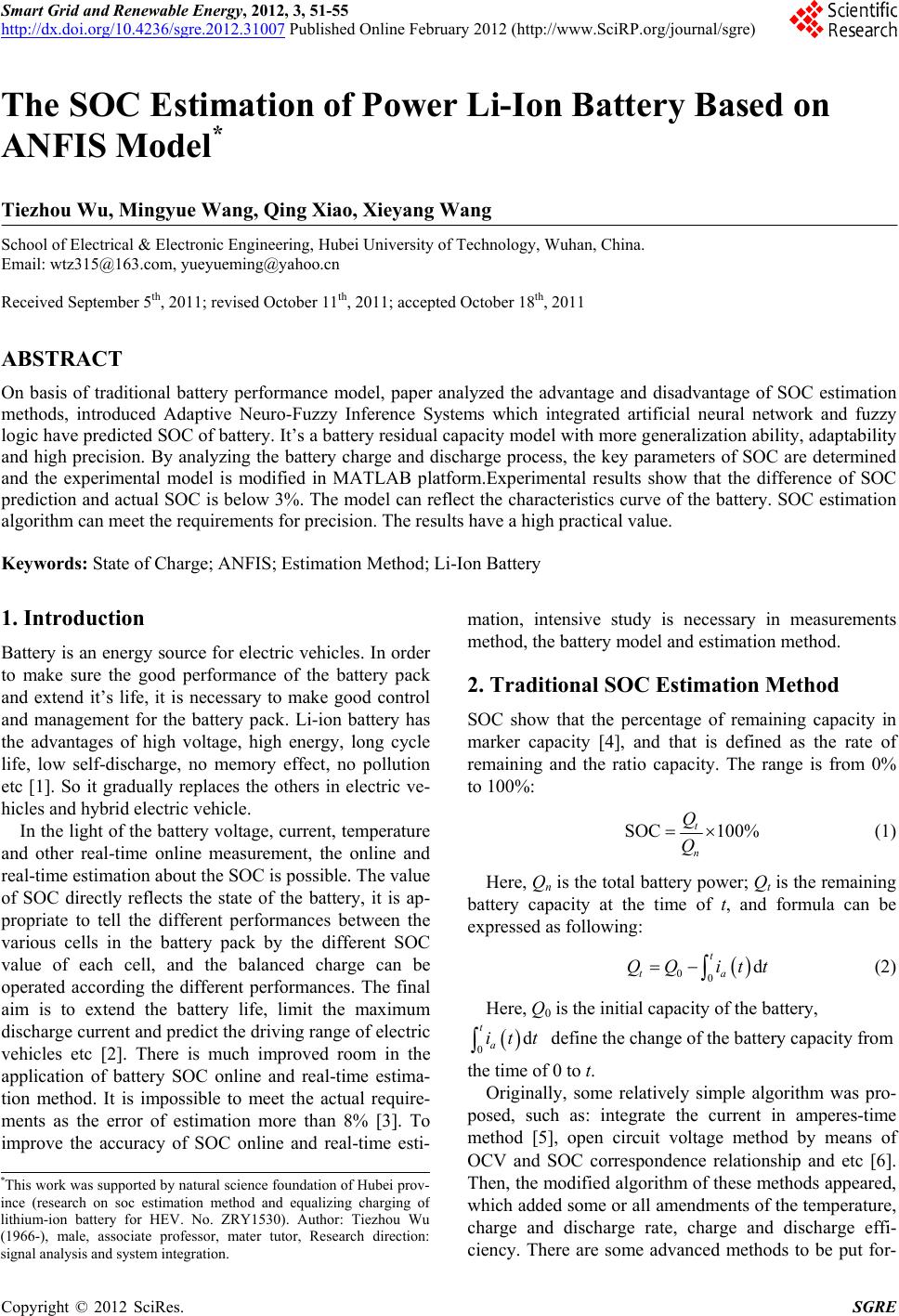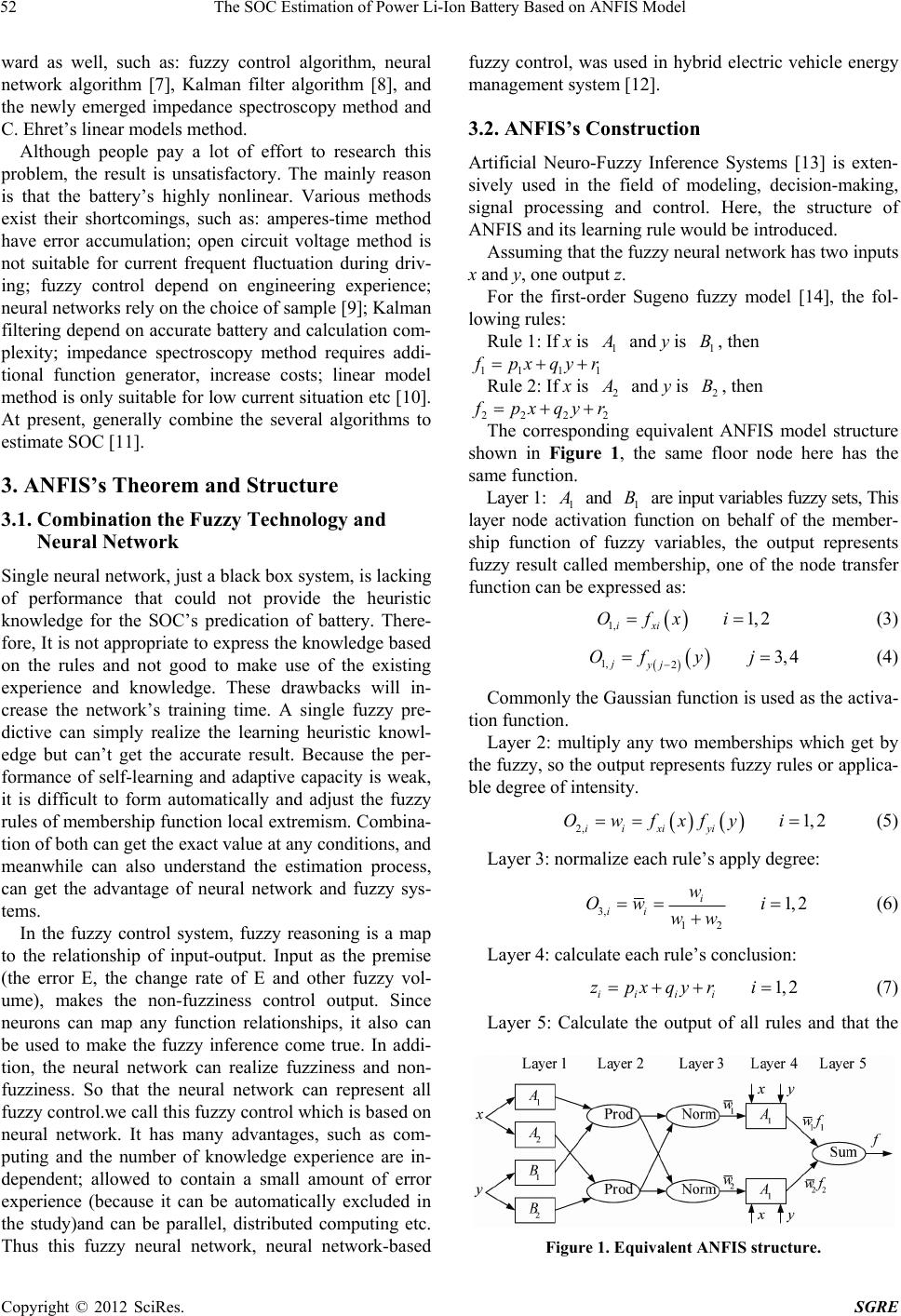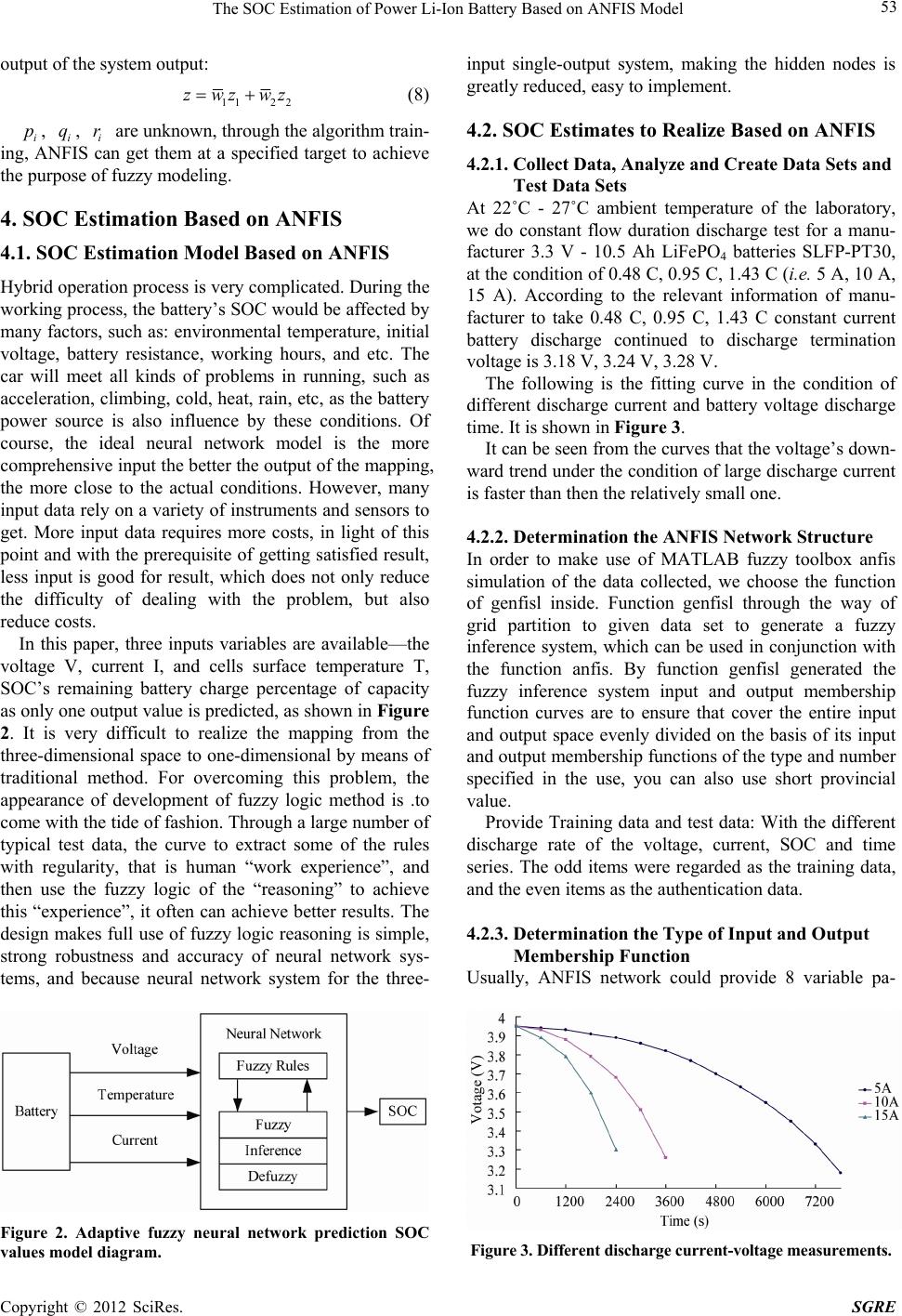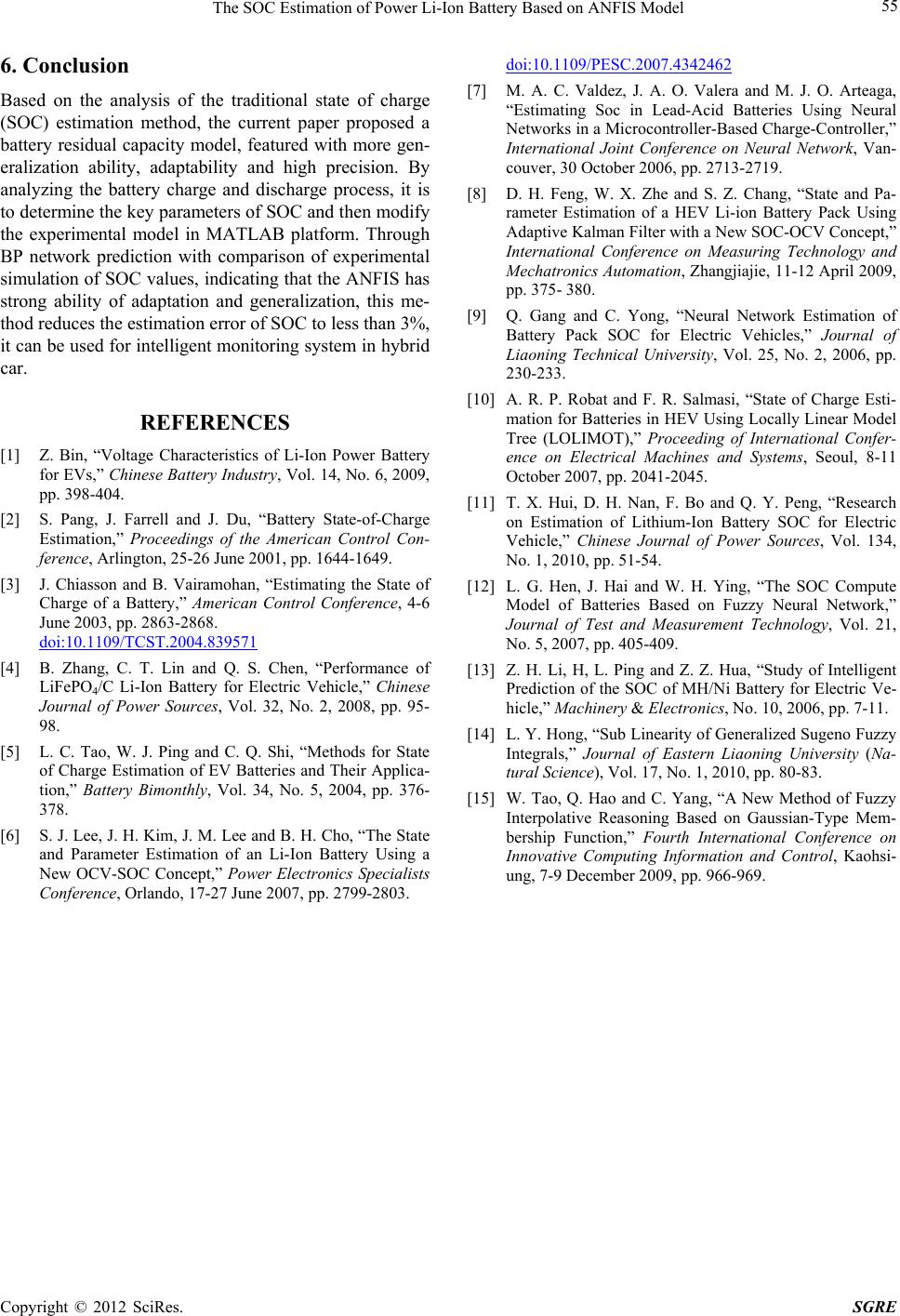 Smart Grid and Renewable Energy, 2012, 3, 51-55 http://dx.doi.org/10.4236/sgre.2012.31007 Published Online February 2012 (http://www.SciRP.org/journal/sgre) 51 The SOC Estimation of Power Li-Ion Battery Based on ANFIS Model* Tiezhou Wu, Mingyue Wang, Qing Xiao, Xieyang Wang School of Electrical & Electronic Engineering, Hubei University of Technology, Wuhan, China. Email: wtz315@163.com, yueyueming@yahoo.cn Received September 5th, 2011; revised October 11th, 2011; accepted October 18th, 2011 ABSTRACT On basis of traditional battery performance model, paper analyzed the advantage and disadvantage of SOC estimation methods, introduced Adaptive Neuro-Fuzzy Inference Systems which integrated artificial neural network and fuzzy logic have predicted SOC o f b attery. It’s a battery resid u al capacity model with more generalization ab ility, adaptab ility and high precision. By analyzing the battery charge and discharge process, the key parameters of SOC are determined and the experimental model is modified in MATLAB platform.Experimental results show that the difference of SOC prediction and actual SOC is below 3%. The model can reflect the characteristics curve of th e battery. SOC estimation algorithm can meet the requirements for precision. The results have a high practical value. Keywords: State of Charge; ANFIS; Estimation Method; Li-Ion Battery 1. Introduction Battery is an energy source for electric vehicles. In order to make sure the good performance of the battery pack and extend it’s life, it is necessary to make good control and management for the battery pack. Li-ion battery has the advantages of high voltage, high energy, long cycle life, low self-discharge, no memory effect, no pollution etc [1]. So it gradually replaces the others in electric ve- hicles and hybrid electric vehicle. In the light of the battery voltage, current, temperature and other real-time online measurement, the online and real-time estimation about the SOC is possible. The value of SOC directly reflects the state of the battery, it is ap- propriate to tell the different performances between the various cells in the battery pack by the different SOC value of each cell, and the balanced charge can be operated according the different performances. The final aim is to extend the battery life, limit the maximum discharge current and predict the driving range of electric vehicles etc [2]. There is much improved room in the application of battery SOC online and real-time estima- tion method. It is impossible to meet the actual require- ments as the error of estimation more than 8% [3]. To improve the accuracy of SOC online and real-time esti- mation, intensive study is necessary in measurements method, the battery model and estimation method. 2. Traditional SOC Estimation Method SOC show that the percentage of remaining capacity in marker capacity [4], and that is defined as the rate of remaining and the ratio capacity. The range is from 0% to 100%: SOC 100% t n Q Q (1) Here, Qn is the total battery power; Qt is the remaining battery capacity at the time of t, and formula can be expressed as following: 00d t ta QQ itt (2) Here, Q0 is the initial capacity of the battery, 0d t a itt define the change of the battery capacity from the time of 0 to t. Originally, some relatively simple algorithm was pro- posed, such as: integrate the current in amperes-time method [5], open circuit voltage method by means of OCV and SOC correspondence relationship and etc [6]. Then, the modified algorithm of these methods appeared, which added some or all amendments of the temperature, charge and discharge rate, charge and discharge effi- ciency. There are some advanced methods to be put for- *This work was supported by natural science foundation of Hubei prov- ince (research on soc estimation method and equalizing charging o lithium-ion battery for HEV. No. ZRY1530). Author: Tiezhou Wu (1966-), male, associate professor, mater tutor, Research direction: signal analysis and system integration. Copyright © 2012 SciRes. SGRE  The SOC Estimation of Power Li-Ion Battery Based on ANFIS Model 52 ward as well, such as: fuzzy control algorithm, neural network algorithm [7], Kalman filter algorithm [8], and the newly emerged impedance spectroscopy method and C. Ehret’s linear models method. Although people pay a lot of effort to research this problem, the result is unsatisfactory. The mainly reason is that the battery’s highly nonlinear. Various methods exist their shortcomings, such as: amperes-time method have error accumulation; open circuit voltage method is not suitable for current frequent fluctuation during driv- ing; fuzzy control depend on engineering experience; neural networks rely on the choice of sample [9]; Kalman filtering depend on accurate battery and calculation com- plexity; impedance spectroscopy method requires addi- tional function generator, increase costs; linear model method is only suitable for low current situation etc [10]. At present, generally combine the several algorithms to estimate SOC [11]. 3. ANFIS’s Theorem and Structure 3.1. Combination the Fuzzy Technology and Neural Network Single neural network, just a black box system, is lacking of performance that could not provide the heuristic knowledge for the SOC’s predication of battery. There- fore, It is not appropriate to express the knowledge based on the rules and not good to make use of the existing experience and knowledge. These drawbacks will in- crease the network’s training time. A single fuzzy pre- dictive can simply realize the learning heuristic knowl- edge but can’t get the accurate result. Because the per- formance of self-learning and adaptive capacity is weak, it is difficult to form automatically and adjust the fuzzy rules of membersh ip function local extremism. Combina- tion of both can get the exact value at any conditions, and meanwhile can also understand the estimation process, can get the advantage of neural network and fuzzy sys- tems. In the fuzzy control system, fuzzy reasoning is a map to the relationship of input-output. Input as the premise (the error E, the change rate of E and other fuzzy vol- ume), makes the non-fuzziness control output. Since neurons can map any function relationships, it also can be used to make the fuzzy inference come true. In addi- tion, the neural network can realize fuzziness and non- fuzziness. So that the neural network can represent all fuzzy control.we call this fuzzy control which is based on neural network. It has many advantages, such as com- puting and the number of knowledge experience are in- dependent; allowed to contain a small amount of error experience (because it can be automatically excluded in the study)and can be parallel, distributed computing etc. Thus this fuzzy neural network, neural network-based fuzzy control, was used in hybrid electric vehicle energy management system [12]. 3.2. ANFIS’s Construction Artificial Neuro-Fuzzy Inference Systems [13] is exten- sively used in the field of modeling, decision-making, signal processing and control. Here, the structure of ANFIS and its learning rule would be introduced. Assuming that the fuzzy neural network has two inputs x and y, one output z. For the first-order Sugeno fuzzy model [14], the fol- lowing rules: Rule 1: If x is 1 and y is , then 1 B 11 11 px qyr Rule 2: If x is 2 and y is , then 2 B 22 22 px qy r The corresponding equivalent ANFIS model structure shown in Figure 1, the same floor node here has the same function. Layer 1: 1 and 1 are input variables fuzzy sets, This layer node activation function on behalf of the member- ship function of fuzzy variables, the output represents fuzzy result called membership, one of the node transfer function can be expressed as: B 1, ixi Ofx (3) 1, 2i 1, 2 jyj Of y (4) 3,4j Commonly the Gaussian function is used as the activa- tion function. Layer 2: multiply any two memberships which get by the fuzzy, so the output represents fuzzy rules or applica- ble degree of intensity. 2,ii xiyi Owfxfy (5) 1, 2i Layer 3: normalize each rule’s apply degree: 3, 12 i ii w Ow ww (6) 1, 2i Layer 4: calculate each rule’s conclusion: ii i zpxqyr i (7) 1, 2i Layer 5: Calculate the output of all rules and that the Figure 1. Equivalent ANFIS structure. Copyright © 2012 SciRes. SGRE  The SOC Estimation of Power Li-Ion Battery Based on ANFIS Model 53 output of the system output: 112 2 zwzwz (8) i, i, i are unknown, through the algorithm train- ing, ANFIS can get them at a specified target to achieve the purpose of fuzzy modeling. p q r 4. SOC Estimation Based on ANFIS 4.1. SOC Estimation Model Based on ANFIS Hybrid operation process is very complicated. During the working process, the battery’s SOC would be affected by many factors, such as: environmental temperature, initial voltage, battery resistance, working hours, and etc. The car will meet all kinds of problems in running, such as acceleration, climbing, cold, heat, rain, etc, as the battery power source is also influence by these conditions. Of course, the ideal neural network model is the more comprehensive input the better the output of the mapping, the more close to the actual conditions. However, many input data rely on a variety of instruments and sensors to get. More input data requires more costs, in light of this point and with the prerequisite of getting satisfied result, less input is good for result, which does not only reduce the difficulty of dealing with the problem, but also reduce costs. In this paper, three inputs variables are available—the voltage V, current I, and cells surface temperature T, SOC’s remaining battery charge percentage of capacity as only one output valu e is predicted, as shown in Figure 2. It is very difficult to realize the mapping from the three-dimensional space to one-dimensional by means of traditional method. For overcoming this problem, the appearance of development of fuzzy logic method is .to come with the tide of fashion. Through a large number of typical test data, the curve to extract some of the rules with regularity, that is human “work experience”, and then use the fuzzy logic of the “reasoning” to achieve this “experience”, it often can achieve better results. The design makes full use of fuzzy logic reasoning is simple, strong robustness and accuracy of neural network sys- tems, and because neural network system for the three- Figure 2. Adaptive fuzzy neural network prediction SOC values model diagram. input single-output system, making the hidden nodes is greatly reduced, easy to implement. 4.2. SOC Estimates to Realize Based on ANFIS 4.2.1. Collect Da ta, Analyze and Crea te D at a Se ts an d Test Data Sets At 22˚C - 27˚C ambient temperature of the laboratory, we do constant flow duration discharge test for a manu- facturer 3.3 V - 10.5 Ah LiFePO4 batteries SLFP-PT30, at the condition of 0.48 C, 0.95 C, 1.43 C (i.e. 5 A, 10 A, 15 A). According to the relevant information of manu- facturer to take 0.48 C, 0.95 C, 1.43 C constant current battery discharge continued to discharge termination voltage is 3.18 V, 3.24 V, 3. 2 8 V. The following is the fitting curve in the condition of different discharge current and battery voltage discharge time. It is shown in Figure 3. It can be seen from the curves that the voltage’s down- ward trend under the condition of large discharge current is faster than then the relatively small one. 4.2.2. Determination the ANFIS Network Structure In order to make use of MATLAB fuzzy toolbox anfis simulation of the data collected, we choose the function of genfisl inside. Function genfisl through the way of grid partition to given data set to generate a fuzzy inference system, which can be used in conjunction with the function anfis. By function genfisl generated the fuzzy inference system input and output membership function curves are to ensure that cover the entire input and output space evenly divided on the basis of its input and output membership functio ns of the type an d number specified in the use, you can also use short provincial value. Provide Training data and test data: With the different discharge rate of the voltage, current, SOC and time series. The odd items were regarded as the training data, and the even items as the authentication data. 4.2.3. Determination the Type of Input and Output Membership Functi on Usually, ANFIS network could provide 8 variable pa- Figure 3. Different discharge current-voltage measurements. Copyright © 2012 SciRes. SGRE  The SOC Estimation of Power Li-Ion Battery Based on ANFIS Model Copyright © 2012 SciRes. SGRE 54 rameters of the function type MF. In the current paper, the Gaussian membership function (Gaussmf) is applica- tion [15]. Since ANFIS is a Sugeno type fuzzy system, so there are two output variables membership functions, namely: constant and linear functions. In this paper, con- stant, that the first order Sugeno fuzzy system. problem of the error function, using steepest descent for nonlinear programming method, in accordance with the error function of the negative gradient direction to mod- ify the weights, so it existence the disadvantage of low learning efficiency, slow convergence, and vulnerable Local minimum state, relatively poor network generali- zation ability. 4.2.4. Divination Inpu t Variable Space The following is a BP network, ANFIS model com- parison in predicted remaining battery capacity. First determine the maximum and minimum input vari- ables: then order the collected data to obtain the mini- mum and maximum input variables; finally, establish three fuzzy sets for each input variable, the correspond- ing generated results are high, low, medium membership functions, the input space is the input variables corre- sponding to the product of the membership. The output value from correspo nding is between 0 and 1. Figure 4 shows the compared curve between predic- tive value and measured one of the remaining capacity of 8 A constant discharge. Figure 5 shows the remaining capacity under the 20A constant discharge predicted and measured values of the contrast curve. According to the Figures 4 and 5, under the experi- mental condition, compared the SOC’s predictive value and actual one, the majority of relative error could be controlled within 5%. What’s more, the predictive effect of ANFIS model is better and the error could be con- trolled within 3%, which would not only meet the re- quirements of industrial applications, but is suitable to apply for the actual predictive research. And from the view of training steps and training time, ANFIS model to predict SOC is more efficient, ideal for real-time predic- tion. 5. Experimental Validation and Analysis The selection of training data may give unreliable results bring some factors as before mentioned, This addition not only requires some pre-work on the availability of data, training process and the final result of model check- ing is also very important. In general, the result model test procedure is used for training those who do not use as the input/output data, to compare the model is or not trained to a very good match and predict these data. The essence of BP algorithm is to solve the minimum Figure 4. 8 A constant current discharge of the predictive value of SOC compared with the real. Figure 5. 20 A constant current discharge of the predictive value of SOC compared with the real.  The SOC Estimation of Power Li-Ion Battery Based on ANFIS Model 55 6. Conclusion Based on the analysis of the traditional state of charge (SOC) estimation method, the current paper proposed a battery residual capacity model, featured with more gen- eralization ability, adaptability and high precision. By analyzing the battery charge and discharge process, it is to determine the key parameters of SOC and then modify the experimental model in MATLAB platform. Through BP network prediction with comparison of experimental simulation of SOC values, indicating that the ANFIS has strong ability of adaptation and generalization, this me- thod reduces the estimation error of SOC to less than 3%, it can be used for intelligent monitoring system in hybrid car. REFERENCES [1] Z. Bin, “Voltage Characteristics of Li-Ion Power Battery for EVs,” Chinese Battery Industry, Vol. 14, No. 6, 2009, pp. 398-404. [2] S. Pang, J. Farrell and J. Du, “Battery State-of-Charge Estimation,” Proceedings of the American Control Con- ference, Arlington, 25-26 June 2001, pp. 1644-1649. [3] J. Chiasson and B. Vairamohan, “Estimating the State of Charge of a Battery,” American Control Conference, 4-6 June 2003, pp. 2863-2868. doi:10.1109/TCST.2004.839571 [4] B. Zhang, C. T. Lin and Q. S. Chen, “Performance of LiFePO4/C Li-Ion Battery for Electric Vehicle,” Chinese Journal of Power Sources, Vol. 32, No. 2, 2008, pp. 95- 98. [5] L. C. Tao, W. J. Ping and C. Q. Shi, “Methods for State of Charge Estimation of EV Batteries and Their Applica- tion,” Battery Bimonthly, Vol. 34, No. 5, 2004, pp. 376- 378. [6] S. J. Lee, J. H. Kim, J. M. Lee and B. H. Cho, “The State and Parameter Estimation of an Li-Ion Battery Using a New OCV-SOC Concept,” Power Electronics Specialists Conference, Orlando, 17-27 June 2007, pp. 2799-2803. doi:10.1109/PESC.2007.4342462 [7] M. A. C. Valdez, J. A. O. Valera and M. J. O. Arteaga, “Estimating Soc in Lead-Acid Batteries Using Neural Networks in a Microcontroller-Based Charge-Controller,” International Joint Conference on Neural Network, Van- couver, 30 October 2006, pp. 2713-2719. [8] D. H. Feng, W. X. Zhe and S. Z. Chang, “State and Pa- rameter Estimation of a HEV Li-ion Battery Pack Using Adaptive Kalman Filter with a New SOC-OCV Concept,” International Conference on Measuring Technology and Mechatronics Automation, Zhangjiajie, 11-12 April 2009, pp. 375- 380. [9] Q. Gang and C. Yong, “Neural Network Estimation of Battery Pack SOC for Electric Vehicles,” Journal of Liaoning Technical University, Vol. 25, No. 2, 2006, pp. 230-233. [10] A. R. P. Robat and F. R. Salmasi, “State of Charge Esti- mation for Batteries in HEV Using Locally Linear Model Tree (LOLIMOT),” Proceeding of International Confer- ence on Electrical Machines and Systems, Seoul, 8-11 October 2007, pp. 2041-2045. [11] T. X. Hui, D. H. Nan, F. Bo and Q. Y. Peng, “Research on Estimation of Lithium-Ion Battery SOC for Electric Vehicle,” Chinese Journal of Power Sources, Vol. 134, No. 1, 2010, pp. 51-54. [12] L. G. Hen, J. Hai and W. H. Ying, “The SOC Compute Model of Batteries Based on Fuzzy Neural Network,” Journal of Test and Measurement Technology, Vol. 21, No. 5, 2007, pp. 405-409. [13] Z. H. Li, H, L. Ping and Z. Z. Hua, “Study of Intelligent Prediction of the SOC of MH/Ni Battery for Electric Ve- hicle,” Machinery & Electronics, No. 10, 2006, pp. 7-11. [14] L. Y. Hong, “Sub Linearity of Generalized Sugeno Fuzzy Integrals,” Journal of Eastern Liaoning University (Na- tural Science), Vol. 17, No. 1, 2010, pp. 80-83. [15] W. Tao, Q. Hao and C. Yang, “A New Method of Fuzzy Interpolative Reasoning Based on Gaussian-Type Mem- bership Function,” Fourth International Conference on Innovative Computing Information and Control, Kaohsi- ung, 7-9 December 2009, pp. 966-969. Copyright © 2012 SciRes. SGRE
|